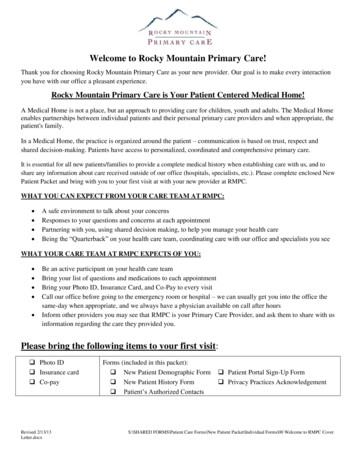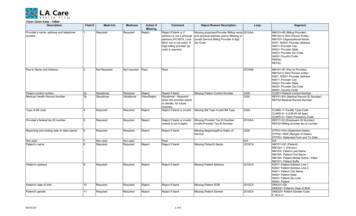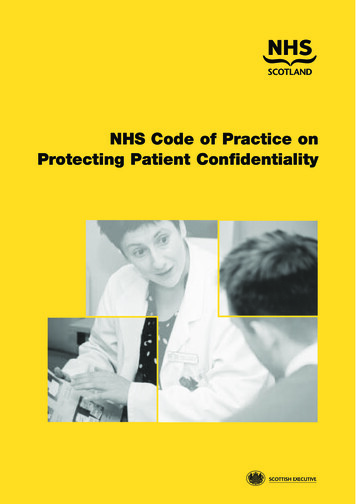
Transcription
APPROACH TO THESWOLLEN PATIENTKeith E Swanson MDND Academy of Family PhysiciansFamily Medicine UpdateJanuary 2017
Disclosures Speaker’s bureau: BMS-Pfizer Should not affect this subject. I “borrowed” many of the images off the internet
Objectives Review basic underpinnings of edema development Provide a comprehensive look at the various causes ofedema Identify key clinical features to “narrow the differential” Brief management pearls
Case 45 y/a healthy male active member of the armed forces CC: leg swelling Over 3 months, sudden onset ankle edema; gradually progressive. R L Never with similar symptoms prior About 10 days prior, had RLE standard venous duplex noncompressibility PTV (1/2) Started on appropriate anticoagulation however edema progresses!! Any thoughts?
What’s going on here? Small “distal” unilateral DVTBilateral progressive edema!! Random urine protein to creatinine Ratio of 3. The REAL reason for his swelling is
Why is Swelling Important? “Am I going to die”? Unattractive, uncomfortable Certainly, in Top 3 reasons for VM consult Mayo VM as well
What’s Behind the Swelling? An increase in the interstitial component of extracellularvolume Generalized edema not clinically apparent until interstitialvolume has increased by 2.5-3 liters 2 overriding factors: 1.altered capillary hemodynamics 2. retention of Na and Water by the kidneys The interplay b/t these 2 factors much more complexthan previously thought
20 L out17 L in3 L lymphatics
Contemporary Understanding of EdemaFormation A more complex interstitial space NOT simply space where a protein free ultra-filtrate of plasma hangs out Actually, a “triphasic” system of free floating fluid, a gel phase, AND acollagen matrix Capillary lumens are very sophisticated Lined with glycocalx composed of complex network of GAG moleculesforming a filtration barrier that is interrupted by clefts though whichcapillary filtration occurs Capillary beds differ substantially depending on organSterns, RH. Pathophysiology and etiology of edema in adults. 2016 UpToDate
Detailed History Sound physical exam Basic labs and imaging Rarely, advancedlabs/imaging.
Welcome to Scotland Yards!!“The causes [of edema] may be obvious and easily recognized, oroccult and taxing to the ingenuity of the most experienced clinician.”William F Ruschhaupt
Pivotal PointsIt’s all in the history! Abrupt vs gradual (timing) Unilateral vs bilateral Pain vs painless Newman’s 1st Law of Medicine
Timing Abrupt, Acute swelling ( 72 hours) DVT, cellulitis, ruptured popliteal cyst, acute compartment syndrome Often unilateral Systemic process Begins simultaneously in each leg and advances to the same degree in each leg Upper limb/facial edema clinches Duration Appears dramatically and disappears completely with recurrences of similar pattern Infectious, recurring injury, idiopathic/cyclic edema NOT Venous insufficiency or chronic lymphatic obstruction Edema behavior can evolve depending on chronicity Lymphedema worse longer one is up on the limb but later, it may diminish.
Pain Edema?PainfulPainless Cellulitis Lymphedema DVT Baker’s cyst ruptureSystemic causes Usually, more generalized Gastroc rupture
LateralityUnilateral More possibilities Big 3: DVT, CVD, Lymphedema Pelvic obstruction Intrinsic OR extrinsicRetroperitoneal fibrosisFictitious Look clues of constrictive deviceh/o of underlying psychiatric diseaseBilateral Usually systemic The 3 “osis” No associated precipitating event If supine, look at sacrum Surrogate for leg swelling in supinePain unlikely
Common Causes of Bilateral EdemaAcuteChronicVenous insufficiencyPulmonary HypertensionHeart FailureIdiopathic edemaDrugsPremenstrual edemaPregnancyObesity
Less Common Causes of Bilateral EdemaAcuteChronicBilateral DVTRenal disease (nephrotic syndrome ornephritis)Acute CHF, Renal diseaseLiver diseaseSecondary Lymphedema (tumor, XRT,infection)Pelvic tumor or lymphoma (extrinsiccompression)Dependent edemaDiuretic inducedPre-eclampsiaLipedema
Rare Causes of Bilateral EdemaAcuteChronicPrimary LymphedemaProtein losing enteropathyRestrictive PericarditisRestrictive cardiomyopathyBeri Beri (Thiaminedeficiency)Myxedema
Common Causes of Unilateral EdemaAcute ( 72 hours)DVTChronicChronic Venous Insufficiency,DVT?
Less Common Causes of Unilateral EdemaAcuteRuptured Baker’s CystRuptured Medial Head of theGastrocnemiusCompartment SyndromeChronicSecondary LymphedemaExtrinsic venous compression(tumor/ lymphoma)Reflex Sympathetic Dystrophy
Rare Causes of Unilateral EdemaAcuteChronicPrimary LymphedemaCongenital VenousMalformationsMay-Thurner SyndromeEly, JW, Approach to leg edema of unclear etiology. J Am Board Fam Med. 2006;18(2):148-160
Other Key Questions Do you sleep in the recliner? s/s OSA Snoring, apneic spells, large neck, daytime somnolence What has your weight done in the past few years? Anything that may have disrupted groin lymphatics Ab surgeries/ lymph node resectionRecurrent leg infectionh/o groin irradiation h/o VV, DVT Activity level
DVT Onset rapid and UNI-lateral Swelling, warmth, slightly reddish, cyanotic hue, tenderness along the deep veins Look for provoking factors h/o of previous DVT OR Thrombophilia Pretest probability Wells score Low to moderate? D dimer. If negative follow closely 1.4% incidence of DVT at 3 monthsHigh: Compression Ultrasound
Chronic Vein Disease Most often due to Incompetent venous valves DVT most commonly implicatedOther causes include genetic and obesityShould be obvious on exam but can be subtle initially Hemosiderin deposition, sclerotic changes, atrophy blanche, ulcer (most commonly justabove the medial malleolus) varicosities Early: soft pitting edema Later: Above
WorldwideUSA
Lymphedema Classification Great for cocktail parties or playing Trivial Pursuit Primary (idiopathic) Congenital present at birth or becomes evident by age 2; if familial “Milroy” syndrome. Lymphedema praecox presents at age 2-35. F:M ratio 10:1; if familial “Meige” disease Most common form of primary lymphedema Usually unilateral and limited to the foot and calf Secondary (obstructive) Much, much more common than primary Usually, not a mystery h/o of previous groin irradiation h/o of cancer h/o of recurrent infection/travel (Filariasis) h/o of surgical manipulation/removal of lymph nodes
Obesity Rates 2015CDC website
Obstructivesleep apneaHigher riskfor DVTobesitylymphedemaVenousinsufficiencyObesity likely most common cause of secondary lymphedema74% of morbidly obese wound pts also had lymphedema21 pt severe lymphedema 100 obese, 91% morbidly
Lymphedema Characteristics Painless, lack of CVD skin changes “Finger-print” pivotal signs “Kaposi-Stemmer” sign unable to pinch 2nd digit dorsal skin fold Dorsal “Hump” sign Prominent skin creases b/t toes and dorsal hump. Early on, difficult to distinguish from early CVD Lymphoscintigraphy Later, a warty texture (hyperkeratosis), brawny induration, cobble-stoning (lymphostatic verrucosis), “ski jump” toe nails
Stemmer’s sign
Case 40 y/o active female, CC swelling end of the day, legs ache. Sometimes, her face and hands will feel puffy No sig PMH, no prescription/OTC meds Labs and venous incompetency study all WNL Notes that when supine, tends to urinate more PCP gave her stockings more pain, swelling no better. Working diagnosis?
Idiopathic Edema Sine qua non: Swelling upright/diuresis supine in women (20-30s) All other etiologies ruled out Heart, Liver, kidney, Meds face and hands; DM, Obesity, “emotional problems” common. Purging behaviors (diuretics, laxatives, vomiting) Abnormal response to assumption of upright posture Normal: mild plasma volume depletion d/t pooling of ECF in LE fall in U NA excretionand daytime wt gain of 0.5-1.5 kg Idiopathic Edema: lose much more fluid from vascular space with standing markedincreased release of hypovolemic hormones (renin, norepi, ADH) increased wt gain(up to 10# in severe cases)
Potential MechanismsIdiopathic Edema Capillary leak not well understood. Precap sphincter tone? Humorally mediated Often have impaired hypothalamic fn abnormal release of prolactin, LH, other hormones.Primary capillary injury?Increased capillary pressure increased capillary permeability movement outExaggerated by gravity in standing. Also explains why JVP not elevated and also why pulmonary edema does NOT develop. Decreased dopamine releaseImpaired regulation of hypothalamic hormone release Could alter capillary hemodynamics directly Dopamine is natriuretic by nature, thus deficiency would result in less Na excretion
Idiopathic EdemaDiagnostics Typically, gain over 1.4 kg (3.08 lbs) over course of day. AM/Evening Weights: Normal 0.46 kg (1.04 lbs)Wt upon arising prior to any food/fluids, nude, empty bladderWt at bedtime,nude,empty bladderDiagnosis suggested if wt gain 0.7 kg (1.54 lbs)Water load Test: More complexMust be off diuretics x 10 d
Idiopathic EdemaManagement Many potential Rx proposed low salt diet, intermittent recumbency, avoidance of excessive heat, wt lossIf on diuretics, stop and wait 3 weeks, warn of rebound!Still edematous spironolactone, Ace I, dopamine agonists (bromocriptine, carbidopalevodopa)Low dose amphetamine: constrict precap sphincter decreased cap hydrostaticpressure less movement o/o capillary.Compression stockings ineffective; not well-tolerated.
Swelling Mimickers
Knee Effusion
LIPedemaAKA: CG-CAPS killerAbnormal fat depositionPainfulStockings worseDoes NOT respond to wt loss“cut off” signTorso: Leg “mismatch”
Klippel-TrenaunaySyndrome1.Port wine stain2.Abnormal veins3.Limb hypertrophy
“When something bad happens (edema), a medication did it until proven otherwise”
Medication related edema Common culprits Thiazolidinediones (pioglitazone, rosiglitazone) Na reabsorption in collecting tubules (same site as aldosterone) May occur insidiously and over months Underlying heart disease increases edema risk Can take 4-6 weeks after stopping to see less edema usually diuretic resistant NSAIDs ( 5% incidence) Corticosteroids Estrogen, testosterone, progesterone Several anti-hypertensives BB, Clonidine, Hydralazine, Minoxidil, Methyldopa
Calcium Channel Blockers Common but dependent on class/dose; vasodilating chronotropic agents. Women MenPerhaps women just more aware of their cosmesis? Possible pharmacokinetic difference suggested at least for some classes (verapamil) This has NOT been seen in other classes Mismatch b/t arteriolar resistance and venule resistance increased hydrostatic pressure LE redness, warmth and non-blanching rash may occur RBC leakage from capillariesDo: Stop, decrease dose, or consider alternate classStockingsConsider administering at nightAdd Ace inhibitor Of course, as BP falls, may be able to decrease CCB as wellDon’t: Give diuretic (not salt/water issue)
Diuretic-induced Edema Persistent diuretic-induced hypovolemia activates several Na retaining mechanisms Once diuretic stopped, pt may be unable to acutely shut off this hormonal adaptation Result: rapid edema formation and the mistaken assumption that chronic diuretic therapyis indicated. If wait 3-4 weeks, often spontaneous diuresis occurs with resolution of edema Study in elderly all taking diuretics solely for ankle edema 75% able to discontinue without persistence of edema Transient rebound common, took about 3 wks to resolve. Chronic high-dose diuretics commonly develop nephrocalcinosis Chronic renal insufficiency All can be partially reversed after diuretic stopped.
“Play the odds” Most common age 50: Chronic Vein Disease Females menarche to menopause: Idiopathic edema Common but unrecognized: PAH/OSA
Sleep Apnea and Edema Poorly understood changes in right sided heart pressures slowing venousreturn. PH NOT a prerequisite for edema In group with edema: 2/3 had OSA but only 1/3 had pulmonary htn Usually, not accompanied by other signs of volumeexcess Unclear whether edema resolves on Rx
Labs/Imaging Simple, readily available labs can rule out/in multiple causes My “edema” filter: UA (proteinuria); BNP (CHF). Cr (renal failure); TSH(hypothyroidism); albumin, PT (synthetic liver function) Imaging: Venous Incompetency Study DVT, venous valvular incompetency, proximal venous waveforms,baker’s cyst MRI/V pelvis in certain cases Echo EF, pulmonary pressures Sleep study Venography
Respirophasic FlowPulsatile Flow
Right CFVLeft CFV
Valsalva
Swanson’s Guide to Edema Management 1.Find the cause 2. Rx the cause 3. if no better, see #1
Compression Pearls Often, not enough Inelastic vs elastic Surround yourself with experts OTR/L Call them, pick their brains Learn from them! Almost all edema can be made better with a compression program not just lymphedema CVD, DVT, dependent edema, combination NOT effective in Lipedema, Idiopathic edema Safe, even with rather severe PAD In fact, may augment arterial flow! Stockings AFTER lymphedema therapy i.e. maintenance Wear while up, on first thing AM (before legs swell)
Swanson’s Secret Weapon
In Summary Edema is common and presents a vast differential to the office clinician Using low tech readily available skills, the diagnosis can usually be identified Spending a bit of time up front on the H/P pays big dividends on the back-end Some causes are common yet often go unrecognizedIdiopathic edema OSA Diuretic induced edema Newman’s first Law (Medications) Effective Rx is dependent on accurate diagnosis My core: OT, Stockings, NephrologyLittle in medicine is more gratifying that effectively treating edema!!
THANK YOU!kswanson@altru.org
Lymphedema Classification Great for cocktail parties or playing Trivial Pursuit Primary (idiopathic) Congenital present at birth or becomes evident by age 2; if familial "Milroy" syndrome. Lymphedema praecox presents at age 2-35. F:M ratio 10:1; if familial "Meige" disease Most common form of primary lymphedema Usually unilateral and limited to the foot and .










